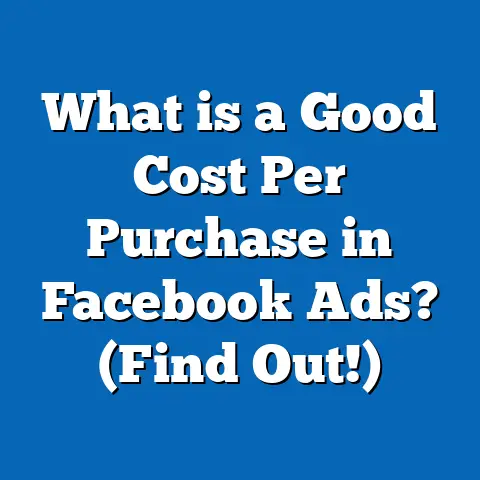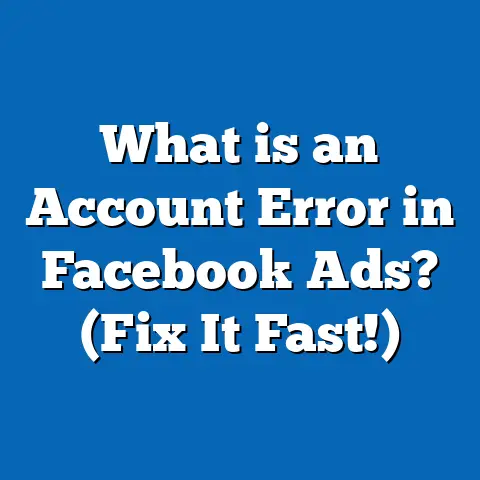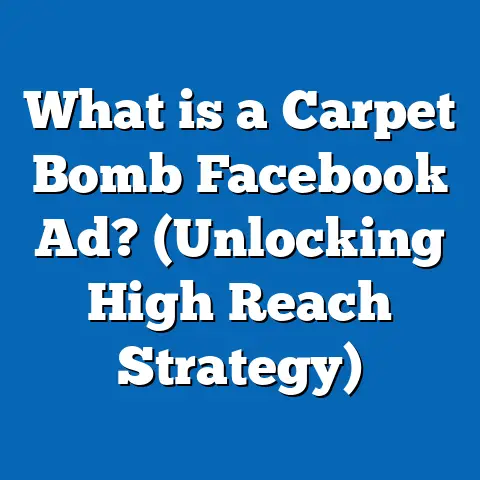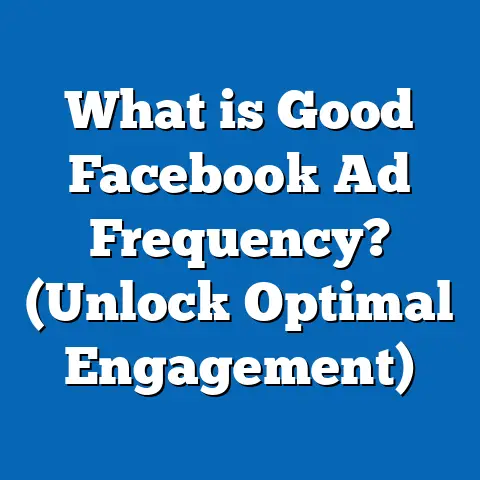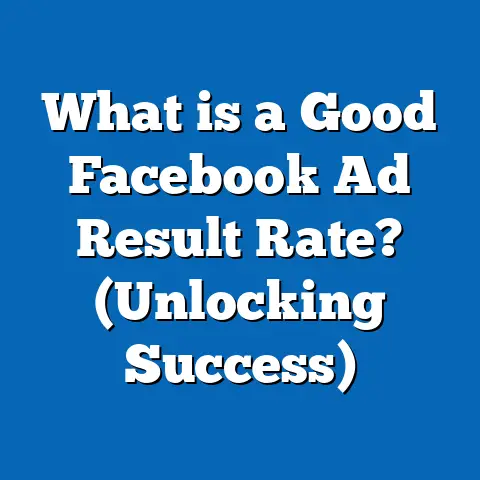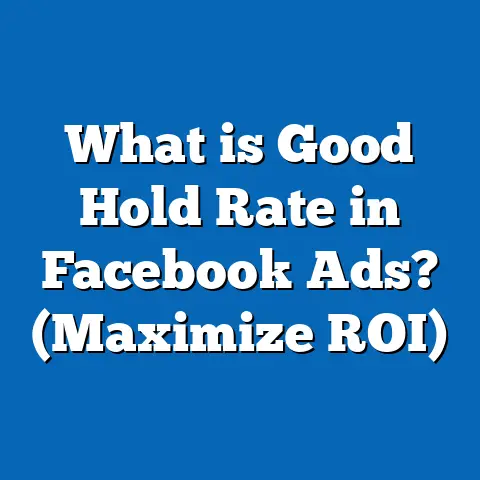What is the Ideal Budget for Facebook Ads? (Maximize ROI)
Are You Spending Too Much—or Too Little—on Facebook Ads?
Have you ever wondered if your Facebook ad budget is holding you back? Most businesses struggle with the same question: What is the ideal budget for Facebook ads to truly maximize ROI? Setting the right budget can mean the difference between burning through cash and building a profitable, scalable campaign. Let’s break down exactly how to find your sweet spot, backed by data, real-world examples, and actionable strategies.
The Power of Facebook Advertising: Why Budget Matters
Facebook remains the world’s largest social platform, with over 3 billion monthly active users as of Q1 2024 (Statista). Businesses of all sizes rely on Facebook for its targeting capabilities and massive reach. However, the platform’s auction-based ad system means that spending too little—or too much—can both sabotage your results.
Key Data Points:
- Average Facebook ad cost per click (CPC): $0.94 (WordStream, 2024)
- Average cost per thousand impressions (CPM): $12.07 (Emplifi, 2024)
- Median conversion rate: 9.21% across all industries (WordStream)
- Advertisers using Facebook: Over 10 million active advertisers (Meta Q1 2024 earnings)
Understanding these benchmarks is essential for setting a realistic and effective budget.
Factors That Influence Your Ideal Facebook Ad Budget
1. Business Goals and Objectives
Budgeting starts with defining your campaign goals. Are you after brand awareness, leads, sales, or app installs? Each objective has different average costs and expected returns.
Example:
- Brand Awareness: Lower cost per result, but less tangible ROI.
- Lead Generation: Higher cost per result, but directly tied to revenue.
- E-commerce Sales: Highest cost per action, but easiest to track ROI.
2. Industry Benchmarks
Certain industries see higher costs due to competition and typical customer value.
| Industry | Avg. CPC | Avg. CPM | Conversion Rate |
|---|---|---|---|
| E-commerce | $0.70 | $11.17 | 2.86% |
| Retail | $0.70 | $7.00 | 3.26% |
| Finance & Insurance | $3.77 | $21.06 | 9.09% |
| Education | $1.06 | $10.73 | 13.58% |
Sources: WordStream, Emplifi
3. Audience Size and Targeting
The broader your audience, generally the lower the CPM—but potentially less relevance. Highly specific targeting (e.g., remarketing) tends to increase costs but also boosts conversion rates.
4. Campaign Duration and Seasonality
Short-term blitzes require larger daily budgets to hit targets fast, while always-on campaigns can spread costs over time. Seasonality impacts competition (e.g., Black Friday = higher CPMs).
5. Ad Creative and Format
Video ads often drive higher engagement but may have higher production costs. Carousel, collection, and instant experience ads each have unique performance profiles.
Calculating Your Ideal Facebook Ad Budget: Step-by-Step Framework
Step 1: Clarify Your Primary Objective
Ask: What action do I want users to take? (e.g., purchase, sign-up, visit website)
Step 2: Know Your Metrics
Identify your average:
- Cost per acquisition (CPA) or cost per lead (CPL)
- Conversion rate
- Lifetime Value (LTV) of a customer
Example:
If your goal is sales and your CPA is $15, with a customer LTV of $140, you can afford a generous budget as long as CPA stays below LTV.
Step 3: Work Backward from Your Revenue Target
Suppose you want $10,000 in new sales and your average order value is $100.
- Number of sales needed: $10,000 / $100 = 100 sales
- Expected conversion rate on landing page: 5%
- Number of clicks required: 100 sales / 0.05 = 2,000 clicks
- Average CPC: $0.94
- Estimated budget: 2,000 clicks x $0.94 = $1,880
Step 4: Factor in Testing and Scaling Costs
Initial testing phases often require more spend to gather data (~$500–$1,000 minimum recommended). Once you identify winning creatives/audiences, gradually scale up by 10–20% every few days.
Unique Insights: The Dangers of Under-Spending and Over-Spending
Under-Spending
- Data Starvation: Small budgets don’t give Facebook’s AI enough data to optimize.
- Slow Learning Phase: Campaigns stay “stuck,” never achieving stable performance.
- Limited Reach: Your ads may not exit the learning phase (Meta recommends at least 50 conversions per ad set per week).
Over-Spending
- Diminishing Returns: Beyond a certain point, higher spend yields less incremental gain.
- Ad Fatigue: Audiences see the same ads repeatedly, reducing CTR and increasing CPC.
- Wasted Spend: Poorly targeted or untested campaigns can quickly burn through large budgets with little return.
How Facebook’s Ad Auction System Impacts Your Budget
Facebook uses an auction system where advertisers bid for placement in users’ feeds based on:
- Bid amount
- Estimated action rates
- Ad quality and relevance
Higher budgets give you more chances to win auctions—but only if your ads are relevant and engaging.
Tip: A high budget with poor creative leads to wasted spend; a low budget with great creative may never reach your audience at scale.
Case Studies: Real Brands Setting Effective Budgets
Case Study #1: Lead Generation for B2B SaaS
Background:
A SaaS startup set an initial daily budget of $20 targeting decision-makers in North America.
Results:
After two weeks ($280 spent), they saw:
- CPM: $18
- Leads: 6
- Cost per lead: ~$46
After increasing daily spend to $60 and optimizing creative:
- CPM dropped to $14
- Leads per week increased by 3x
- Cost per lead dropped to ~$28
Takeaway: Adequate spend plus creative testing drives down costs.
Case Study #2: E-commerce Store Scaling Sales
Background:
An online apparel brand started with a modest $10/day budget.
Results after one month:
- Conversion rate: 2%
- ROAS (Return on Ad Spend): 1.8x (below breakeven)
After raising budget to $50/day and using lookalike audiences:
- Conversion rate rose to 3%
- ROAS increased to 3.2x
- Monthly sales doubled
Takeaway: Scalable budgets unlock Facebook’s optimization potential.
Setting a Minimum Viable Budget for Testing
Meta’s Recommendation
Meta advises aiming for at least 50 conversion events per ad set per week for reliable optimization.
Example Calculation:
If your target CPA is $20:
- 50 conversions x $20 = $1,000 per ad set per week
- Daily minimum recommended: ~$140
For smaller budgets, focus on lower-funnel objectives like engagement or website traffic before scaling up.
Advanced Budgeting Strategies
1. CBO vs. ABO
- Campaign Budget Optimization (CBO): Facebook automatically distributes budget among ad sets for best results.
- Ad Set Budget Optimization (ABO): You manually set budgets for each ad set.
CBO is usually more efficient for scaling; ABO allows more granular control for testing.
2. Dayparting and Scheduling
Analyze your best-performing days/times using Facebook Analytics and allocate more budget during those windows.
3. Incremental Budget Increases
Meta recommends increasing budgets by no more than 20% at a time to avoid resetting the learning phase.
4. Retargeting vs Prospecting Budget Split
Best-practice split for mature accounts:
- 70–80% Prospecting (new audiences)
- 20–30% Retargeting (warm audiences)
This ratio can shift based on campaign maturity and audience size.
ROI Optimization: Making Every Dollar Count
Track Key Metrics Religiously
Monitor:
- ROAS (Return on Ad Spend)
- CPA/CPL
- Impression frequency
- Relevance score
- CTR (Click-through rate)
Use Automated Rules
Set rules in Ads Manager to pause underperforming ads or increase budget only when ROAS exceeds target thresholds.
Creative Testing Is Non-Negotiable
Test multiple creatives/ad copy sets simultaneously (A/B testing). Top-performing creative can cut costs by up to 30% (Meta internal data).
Comparison: Facebook Ad Budgets vs Other Platforms
| Platform | Avg. CPC | Avg. CPM | Typical Minimum Budget |
|---|---|---|---|
| $0.94 | $12 | Flexible ($5+/day) | |
| $1.35 | $14 | Flexible | |
| Google Ads | $2–$4 | $38 | Higher ($20+/day) |
| $5–$7 | $33 | Higher ($20+/day) | |
| TikTok | $1 | $10 | $20+/day |
Facebook offers one of the lowest entry points but requires strategic budgeting for scale.
The Impact of Creative Quality on Budget Efficiency
High-quality creative earns better relevance scores, lowering both CPC and CPM by as much as 25–40%. Invest in professional graphics or video—especially when scaling budgets above $50/day.
Data Trends: New Features Influencing Budget Decisions
Advantage+ Campaigns
Meta’s new “Advantage+” system uses AI to optimize placements/budgets automatically—early adopters report up to 18% lower CPA compared to standard campaigns (Meta data, Q1 2024).
Broad Audience Targeting
With privacy changes (iOS14+), broad targeting is now recommended for many advertisers; this can lower costs but requires higher budgets for effective optimization.
Frequently Asked Questions About Facebook Ad Budgets
Q: What’s the absolute minimum I should spend?
A: For meaningful data, aim for at least $5–$10/day per ad set—but understand results may be slow without more investment.
Q: How often should I change my budget?
A: Only adjust every few days—and by no more than 20%—to allow Facebook’s learning phase to complete.
Q: How do I know if my budget is working?
A: Track ROAS, CPA/CPL, and conversion volume weekly; compare against industry benchmarks and your business goals.
Pro Tips from Industry Experts
- Start small but ramp quickly once you spot winners—don’t let fear of spend limit your growth.
- Allocate part of your budget solely for creative testing; even top-performing ads fatigue after a few weeks.
- Use dynamic creative tools for automatic mix-and-match of images/copy.
- Regularly review attribution windows as changes directly impact reported ROI.
- Set aside emergency “scaling” funds during high-conversion periods (e.g., holiday sales).
Takeaways & Next Steps
- There’s no one-size-fits-all budget; it depends on your goals, industry benchmarks, audience size, and creative quality.
- Always allocate enough budget to exit the learning phase—at least 50 conversions/week/ad set is a solid target.
- Test aggressively with smaller budgets before scaling up.
- Use CBO for efficiency at scale; ABO for precision when testing.
- Monitor metrics relentlessly and automate optimization where possible.
- Keep an eye on Meta’s new features—those who adapt early tend to capture better results at lower costs.
Next Steps:
- Audit your current campaigns for performance gaps.
- Set clear goals and work backward to calculate your needed investment.
- Allocate a test budget; commit to gathering actionable data before scaling.
- Experiment with creative and audience targeting regularly.
- Stay updated with Meta policy changes and platform innovations.
Remember: The ideal Facebook ad budget isn’t about spending the most—it’s about spending smartly to maximize every dollar’s return.
References available upon request.

